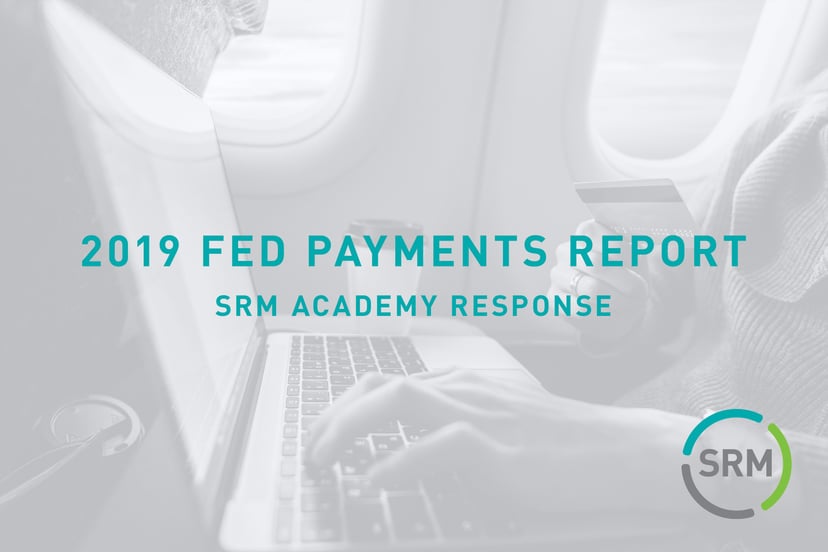![Trends_2022_Part2_Blog_Image[15]](https://blog.srmcorp.com/hs-fs/hubfs/Trends_2022_Part2_Blog_Image%5B15%5D.png?width=932&name=Trends_2022_Part2_Blog_Image%5B15%5D.png)
In a recent post, we discussed two trends we anticipate driving strategy discussions for bank and credit union leadership teams in 2022. Our first trend breakdown focused on operational items – including back-office automation, loan originations, branch footprints, and artificial intelligence.
This blog will look at evolving customer trends that financial institutions (FIs) should address to maintain their valuable status as financial services providers of choice.
Read More
Topics:
Payments,
Vendor Contract Negotiation,
Credit Card,
Cryptocurrency,
Bank Vendor Management,
Credit Union Vendor Management,
Buy Now Pay Later
![Reg-II-Comments-Blog-Image[27]](https://blog.srmcorp.com/hs-fs/hubfs/Reg-II-Comments-Blog-Image%5B27%5D.png?width=836&name=Reg-II-Comments-Blog-Image%5B27%5D.png)
As discussed in a previous blog, the Federal Reserve began seeking comments on proposed changes to Reg II of the Durbin Amendment in May. At that time, the Fed said that it felt the changes would be non-substantial and would not include more compliance obligations. Currently, the Fed bars issuers from restricting the number of unaffiliated networks for debit card transactions to fewer than two, including one signature network and one PIN network. The new proposal would make issuers responsible for ensuring that all transactions with US merchants can be routed across two unaffiliated networks.
While the Fed characterized this change as a simple clarification, it is anything but, as evidenced by the over 2,600 comments received. It is clear this issue is complex, substantial, and would increase compliance obligations.
We have sorted through the comments posted on the Fed's website and various government sites to summarize the key points for both sides of this argument.
Read More
Topics:
Payments,
Credit Union Vendor Management,
Durbin Amendment,
Regulations
![Durbin_Blog_Image[57]](https://blog.srmcorp.com/hs-fs/hubfs/Durbin_Blog_Image%5B57%5D.png?width=841&name=Durbin_Blog_Image%5B57%5D.png)
Rumor is that a further tightening of the Durbin Amendment is on the near-term horizon for card issuers. The most concrete evidence is the Fed’s May request-for-comment on regulations for debit routing of online transactions.
The Fed wants to clarify the regulatory requirement that at least two unaffiliated payment card networks must be enabled for all debit card transactions, including card-not-present (CNP), and card-issuing banks and credit unions will be held responsible. Some terminology will also see standardization.
While the Fed positioned its query as a “non-substantive clarification,” many of the 453 comments submitted so far express a belief that the proposal, if enacted, would have a significant impact on issuers. Meanwhile, bankers are entering a period of uncertainty as they closely monitor the situation for implications to P&L.
Read More
Topics:
Payments,
Vendor Contract Negotiation,
Durbin Amendment,
Regulations

In recent years, challenger banks, neobanks, and other fintech startups have intensified their efforts to compete as financial services providers. Now, regulators have renewed interest in shifting the odds in their favor.
By obtaining a new specialized charter through the Office of the Comptroller of the Currency (OCC), new competitors may gain strategic advantages over more conventional banks and credit unions.
Here is a closer look at some legal and regulatory developments which could determine just how entrenched fintechs will become in the payments system – and how competitive they can be with core banking products and services.
Read More
Topics:
Payments,
Fintech,
Digital Banking,
FDIC,
Challenger Bank,
Neobank,
Growth Strategies

Bitcoin’s value - which has doubled in 2021 - continues to generate headlines but, behind the scenes, something even more significant for banking, as we know it, is happening. Central bank digital currencies are now emerging from experimental trials, disrupting the norm, to take a leading role on the global payments stage.
As for banks and credit unions, we recommend researching and rehearsing your crypto lines (of business) for showtime.
Read More
Topics:
Payments,
Cryptocurrency,
DeFi,
Disruptors,
CBDCs,
Central Bank Digital Currencies

Let’s begin by stating the obvious: this will not be a normal election season. As it has for so many aspects of everyday life, COVID has radically altered the basics of voting- from a huge uptick in advance and absentee ballots to the near-elimination of traditional campaign rallies.
We know that markets hate uncertainty – and that’s one thing in ample supply these days. Uncertainty creates hesitancy to invest in initiatives that could be upended based on the election outcome. This is especially problematic in our current environment, with so many critical issues clamoring to be addressed.
Read More
Topics:
Payments,
Payment Strategies

January’s release of the 2019 Payments Study from the Federal Reserve reveals that American purchasing behavior is evolving at full force, especially in debit and credit card use. Every three years, the Fed releases a comprehensive study on usage trends for noncash payment instruments. This most recent data shows the persistence of several longstanding trends – and some are gaining speed.
Read More
Topics:
Payments,
Vendor Contract,
Cardless,
Noncash,
Debit and Credit,
Payment Strategies

Las Vegas played host to another Money 20/20 the last week of October, this year’s theme being, "Journey to the Future of Money." Payments experts and influencers from the likes of eBay, Uber, Amazon and Mastercard took the stage to share their predictions on how the movement of money is changing, and to offer advice for how we can all respond.
Read More
Topics:
Payments,
Money 20/20

The Pew Research Center defines Generation Z as anyone born in 1996 or later. A watershed event occurred in 2007 with the introduction of the first iPhone, which maps well to the generational differentiator about Gen Z having little experience with pre-smartphone technology.
Read More
Topics:
Payments,
Fintech,
Digital Banking,
Generation Z

Major League Baseball just completed its All-Star Break, which is traditionally seen as an opportunity to assess the season’s performances to date. We at SRM do something similar, revisiting our annual list of industry trends impacting banks and credit unions’ growth strategies and vendor contract relationships.
It’s been an action-packed first half of 2019. The trends we highlighted at the beginning of 2019 are actively shaping the financial services market and decisions being made by banks and credit unions. Here’s a quick summary to detailed analysis of the topics we’ve provided throughout the year.
Read More
Topics:
Payments,
Voice Technology,
Vendor Contract,
SaaS,
Vendor Contract Negotiation
![Trends_2022_Part2_Blog_Image[15]](https://blog.srmcorp.com/hs-fs/hubfs/Trends_2022_Part2_Blog_Image%5B15%5D.png?width=932&name=Trends_2022_Part2_Blog_Image%5B15%5D.png)
![Reg-II-Comments-Blog-Image[27]](https://blog.srmcorp.com/hs-fs/hubfs/Reg-II-Comments-Blog-Image%5B27%5D.png?width=836&name=Reg-II-Comments-Blog-Image%5B27%5D.png)
![Durbin_Blog_Image[57]](https://blog.srmcorp.com/hs-fs/hubfs/Durbin_Blog_Image%5B57%5D.png?width=841&name=Durbin_Blog_Image%5B57%5D.png)









